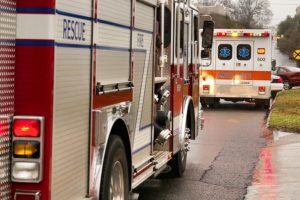According to data from the American Burn Association (ABA), over 450,000 serious burn injuries occur in the United States each year. Approximately 10,000 people die every year from burn-related infections. Open flames, electrical currents, chemicals, or other causes may lead to burn injuries. The effects of burns on children and adults alike can be devastating and life-altering.
The majority of burn injuries and deaths are preventable, and many burn injuries result from another person’s carelessness. If you suffered burn injuries as the result of someone else’s negligence, consult a South Carolina burn injury attorney to discuss your legal options. Contact the Hughey Law Firm today for more information.
Common Causes of Burn Injuries
A burn injury can happen in a variety of situations and locations from the workplace to the home. For older adults, smoking and open flames are common causes of burn injuries. In children, scalding causes the most burns—typically kitchen and bathtub scalding injuries. When people think of burns, they usually think only of fires, but many kinds of accidents can lead to burns.
For example, if someone was involved in a car accident with a truck carrying hazardous materials, they could sustain a radiological or chemical burn.
The causes of burn injuries include:
- Flames or fire causes approximately 44 percent of all burn injuries. Flame burns may result from building fires, motor vehicle accidents, careless smoking, negligent handling of flammable objects, or clothing that caught fire from stoves and heaters. In addition to the burns, the smoke from flames and fire can lead to respiratory problems.
- A flash burn is the result of sudden intense heat, such as an explosion of gasoline, propane, natural gas, or other flammable liquid. Clothing may provide some protection, but if it contains flammable material, it may ignite.
- Dry heat, such as from a clothes iron, can causes burns. Wet heat, such as hot water or steam, causes scalding injuries. Scald burns are responsible for about 35 percent of burn injuries. Tragically, 61 percent of scalding accidents happen to children under the age of five. Hot bath water causes more than half of all scalds in children.
- Electrical burns. These burns happen when electricity comes in contact with your body. Electricity, including from lightning, exposed wiring, downed power lines, or contact with household current, may cause electrical burns. They are especially dangerous because electrical currents can also move through the body, potentially damaging tissues and organs.
- Chemical burns. Chemical burns, also known as caustic burns, happen when your skin comes into contact with an irritant, such as an acid. For example, in a car accident, the airbag deployment may trigger a chemical reaction, or you may come in contact with steering or transmission fluid.
- Friction burns. These are both abrasions and heat burns. Friction burns may become infected and, in some cases, can even affect muscle and bone. They usually occur when the skin gets dragged over a rough surface. This type of burn is common in motorcycle and bike accidents.
- Burns caused by e-cigarette batteries. As e-cigarettes have become increasingly popular, the batteries that power the e-cigarettes are increasingly causing injuries. Some of these are particularly severe. According to the U.S. Consumer Product Safety Commission (CPSC), in a recent two-year period, an estimated 2,035 e-cigarette explosion and burn injuries required hospital treatment.
Classification of Burn Injuries
Doctors classify burns based on how deep they are and how large an area they cover. If the burn injury covers a large area, it may include burned areas of different depths. In addition to the skin, severe burns may damage deeper tissues, muscles, and bones.
The four primary classifications—or degrees—of burns include:
- First-degree burns. These are often the least serious, as they only damage the very top layer of skin. Home treatment is appropriate for some first degree burns.
- Second-degree burns. Second-degree burns affect the outer layer of skin, called the epidermis, and part of the second layer of skin called the dermis. They are more serious and may require medical attention. Second degree burns often present with blisters and can leave scars.
- Third-degree burns. These are sometimes called a full-thickness burn. They destroy the outer layer of the skin (epidermis) and the entire layer beneath (the dermis). Victims of third-degree burns may need skin grafts, and they may suffer nerve damage.
- Fourth-degree burns. Prolonged contact with fire can result in the most serious type of thermal burn, referred to as a fourth-degree burn. These are the deepest and most severe of burns, and they may be life-threatening. Not only do they destroy the skin, but they can damage the muscles, tendons, and bones.
Common Burn Treatments
Burn treatments vary widely, based on the cause and severity of the burn. Upon assessing a burn, the doctor may recommend treating minor burns at home. However, treatment for serious burns is much more complex. Each burn requires special care. Treatment goals and strategies vary, depending on the patient’s injury, stage of treatment, age, and other health conditions.
The goal of treatment is to prevent infection, minimize loss of range of motion, remove dead tissue, reduce scarring, and control pain levels. Treatments may include special burn dressings, skin grafts, and medications. Many victims undergo physical, mental, or occupational therapy. Burn injuries may lead to visible scars, and can cause emotional and psychological trauma. Those with severe burns may need treatment at specialized burn centers.
Burn injury treatment can be very expensive. Costs for a moderate injury may exceed $200,000. Severe burn injuries can cost $1.5 million or more.
Treatments may include:
- Water-based treatments.
- Intravenous fluids to prevent dehydration and organ failure.
- Pain and anxiety medications. Burns can be incredibly painful.
- Drugs that fight infection.
- Dressings appropriate for wound care.
- Creams and ointments for burn care. These help the wound close and work to prevent infection.
- Ongoing physical and occupational therapy.
Complications of Burn Injuries
 Burns are catastrophic injuries that can result in serious disability and disfigurement.
Burns are catastrophic injuries that can result in serious disability and disfigurement.
Physical complications may include:
- Respiratory issues. Inhaling smoke and hot ash can damage the lungs. It may also burn the mouth and tongue, as well as the throat, larynx, and esophagus.
- Infections. Burn sites are open wounds and can easily become infected or even lead to sepsis.
- Contractures. Scar tissue from burns may tighten up as time passes. This tightening, known as contractures, can make movement painful or breathing difficult.
- Compromised immune systems. If a burn injury results in organ damage or infections, it may affect the immune system.
Other common complications from burn injuries include:
- Psychological complications.
- Disfigurement.
- Skin breakdown.
- Skin graft failure.
Lawsuits Based on Burn Injuries
It can be very difficult to determine who is at fault for causing a burn injury. However, many times, it is the negligence of an individual or a business that causes people to suffer burn injuries. There may be one factor that led to the injury, such as a defective product, someone’s erroneous use of chemicals, or failure to install necessary fire safety equipment. However, in some cases, more than one party is to blame.
For example, a hotel fire may start with flammable furniture, but other complications arise such as smoke detector failure or a lack of sprinklers. Therefore, the hotel, furniture manufacturer, and smoke detector manufacturer might all bear responsibility for the burn injuries.
Determining liability often requires careful investigation and expert testimony.
Legal theories behind burn injury lawsuits include:
- Negligence, which means “a failure to behave with the level of care that someone of ordinary prudence would have exercised under the same circumstances.” Negligent behavior may consist of actions, but if there is a duty to act, it may consist of an omission. For example, negligence may cause an injury in motor vehicle accidents, electrical accidents, defective products, locked fire exits, or recreational fires.
- Product defects. When a defective product causes a burn injury, the company that produced or sold the product may be liable for damages. Under South Carolina law, whenever a consumer product has a defect or design flaw that makes it hazardous to consumers, it can fall within product liability law.
- Premises liability. Under premises liability laws, property owners and occupiers have to keep the property in a reasonably safe condition. Therefore, if a burn accident happens on another person’s property, the property owner may be liable for damages if a hazard on the property caused the burn injury.
Compensation Following a Burn Injury
The cost of these burn injuries, including medical treatment and lost productivity, can be ruinous. The personal losses and altered life of the victim are far greater. In a burn injury lawsuit, the purpose of compensatory damages is to compensate the injury victim for their injury and losses. The court may award victims economic and non-economic damages. Compared to other types of injuries, burns can be extremely expensive to treat.
Economic Damages for Burn Injuries
Economic damages are tangible losses that can easily be quantified by reviewing records or documents, such as medical records or income statements. They include money the injured person has paid out-of-pocket as well as the money they will need in the future.
Examples of economic damages include:
- Medical bills. Burn injury victims often have enormous medical expenses. Most victims require hospital stays. Many receive treatment in special burn units, skin grafting procedures, and long-term rehabilitation.
- Lost income and lost earning capacity. A permanently disabled burn injury victim can’t always continue their previous employment.
- Property damage.
Non-Economic Damages for Burn Injuries
It is harder to put a price tag on non-economic damages, but the harm is still real and painful.
Damages may include:
- Loss of bodily function or other physical disability.
- Disfigurement.
- Scarring. Burn injuries can lead to permanent and severe scarring.
- Pain and suffering. This is often the largest component of a burn injury award
- Emotional distress.
- Loss of enjoyment in life, such as the injured person’s inability to participate in activities they enjoyed before the injury.
- Loss of consortium.
Punitive damages are only awarded in special cases, generally where the defendant’s actions were particularly reckless or egregious, or where the defendant may have had actual malice in mind. The court awards these damages to punish the perpetrator and to send a signal to others to refrain from the same sort of harmful activity.
Wrongful Death
If a family member has died because of the negligent or deliberate acts of another, South Carolina’s wrongful death statute, Section 15-51-10 through 60, allows the deceased’s spouse and children to bring a lawsuit. If there is no spouse or children, then the lawsuit benefits the parents of the deceased, and if there are no parents, then the compensation goes to the heirs of the deceased.
Worker’s compensation might be available if the burn injury happened while an employee was on the job.
South Carolina Burn Injury FAQ
Burn injuries are some of the worst injuries that an individual can suffer. Severe burns may result in permanent injury, and individuals in South Carolina may sustain burns during recreational activities, while at work, or even in their own homes.
According to the American Burn Association, approximately 486,000 people each year in the U.S. seek medical treatment for burns. Around 40,000 of those individuals will require hospitalization, and three-quarters of the individuals who require hospitalization for a burn receive their treatment from a specialized burn center. While the survival rate for burn victims is high—nearly 97 percent of individuals who receive medical treatment for burns survive—this can be an intensely painful type of injury from which to recover, and one with a high risk of infection, scarring, and lifelong complications.
If you suffered a burn injury in South Carolina due to the reckless or careless actions of another individual, you can pursue compensation for the expenses and impacts you incurred because of the injury. Below, we discuss some burn injury statistics and then answer some of the most frequently asked questions that we hear from our burn injury clients.
How do I pursue compensation for my South Carolina burn injury?
If your injury resulted from the careless, reckless, or even intentional actions of someone else, you can pursue compensation by filing a South Carolina burn injury lawsuit. This lawsuit is a legal claim filed in civil court that seeks to show who was liable for the accident that caused your burn injury and establish the harm to you financially and emotionally.
What types of accidents cause burns in South Carolina?
Around five percent of the burn injuries experienced in the U.S. each year occur on roadways because of motor vehicle accidents. Accidents involving motorcycles involve a particularly high risk of burn injuries, as no steel frame protects the rider from rough surfaces that can cause friction burns, hot surfaces that can cause thermal burns, and caustic and combustible chemicals that can lead to chemical burns, not to mention an additional possibility of thermal burns. Watercraft are also a common culprit of burns in South Carolina, as chemicals and fumes can cause chemical or thermal burns.
Three-quarters of all burn injuries take place in private homes, meaning that a high percentage of burn injury cases involve premises liability claims. Beneath the wide umbrella of personal injury law, premises liability is a part of the law that deals with a property owner’s responsibility to ensure that their property is free from hazards that could cause injury to their guests.
This legal responsibility not only belongs to private homeowners entertaining guests, but also to landlords who must keep appliances and electrical wiring are up to code for rental units, and commercial property owners, including those in the hospitality industry, who must keep hotels and restaurants free from fire hazards that could harm their customers.
The workplace also accounts for about five percent of all burn injuries occurring in the U.S., with the construction industry—which often works with agents that can cause burns, such as chemicals, electricity, and flammable materials and equipment—accounting for many of the burns that occur in the workplace.
Is my burn serious enough to justify speaking to an attorney about my legal options?
 Did your burn injury require medical treatment and/or hospitalization? Did you miss work because of your injury? Has your injury affected your quality of life, causing you physical pain and suffering, emotional distress, or a loss of the enjoyment of life? If so, then you are certainly justified in seeking the guidance of an attorney. Fortunately, the Hughey Law Firm’s South Carolina burn injury lawyers offer free case evaluations, which provide a no-obligation conversation between you and an experienced attorney to discuss the legal options that are available to you.
Did your burn injury require medical treatment and/or hospitalization? Did you miss work because of your injury? Has your injury affected your quality of life, causing you physical pain and suffering, emotional distress, or a loss of the enjoyment of life? If so, then you are certainly justified in seeking the guidance of an attorney. Fortunately, the Hughey Law Firm’s South Carolina burn injury lawyers offer free case evaluations, which provide a no-obligation conversation between you and an experienced attorney to discuss the legal options that are available to you.
What do I need to prove to receive compensation for my South Carolina burn injury?
The American Bar Association calls burn injury lawsuits a tort claim. As such, plaintiffs must prove two basic issues: liability and damages.
Liability is the legal responsibility for the harm caused.
To obtain compensation for your injury, you must establish legal liability by showing the following elements in your case:
- The at-fault party owed you a duty of care. The duty of care the at-fault party owes you depends on the circumstances of your case, but generally refers to the actions a reasonable person would have taken in similar circumstances.
- There was a breach in the duty of care. The breach refers to the actions that the at-fault party took that violated the duty of care.
- The breach resulted in the accident, which caused your injuries and subsequent impacts and expenses.
The legal term “damage” refers to a payment made for harm done. South Carolina allows those who have suffered burn injuries to pursue the collection of both economic damages and non-economic damages. Economic damages refer to a payment made for the out-of-pocket expenses you have faced, such as wage loss and medical treatment. Non-economic damages refer to a payment made for the impacts that the injury has had on your quality of life.
I was partially at fault for the accident that caused my burn in South Carolina. May I still file a claim?
Yes. However, a court may reduce the award that you receive by the percentage of liability that you bear. If you think you partially caused your burns, you should consult an attorney to ensure that you maximize your chances of recovering compensation.
I was burned on the construction site where I work. Can I file a South Carolina burn injury claim?
Yes, though the question is what type of claim. If your injury occurred during the normal scope of your work duties and your employer must carry worker’s compensation insurance, then you may need to file a worker’s comp claim to receive benefits including wage loss and medical treatment. Most employers in South Carolina who employ at least four people—including part-time, full-time, or even family members who regularly work for them—must provide a worker’s compensation insurance policy for their employees. We can help you file that claim.
A third-party South Carolina burn injury claim is only an option for work-related burn injuries in a few circumstances, such as:
- The liable party is a third-party (not your employer or a co-worker).
- Your employer does not have worker’s compensation insurance, either because the law does not require him or her to provide this policy for employees or because he or she is out of compliance with the law.
The attorneys at Hughey Law Firm have ample experience with both third-party South Carolina burn injury lawsuits as well as worker’s compensation claims and can assist you in understanding which process is the best avenue for obtaining compensation in your case.
What damages can I recover in a South Carolina burn injury case?
Damage awards often include the following costs and impacts of an injury:
- Medical treatment, including treatment at the scene, transport to the emergency department or burn center, diagnostic testing, hospitalization, surgical and physician services, prescription medication, physical therapy, and rehabilitation.
- Future medical treatment that you will likely face in the future as a result of your injury. Burn injuries carry a high risk of dangerous complications such as infection, as well as skin graft procedures to address scarring and the treatment of other complications as necessary.
- Lost wages due to being too injured to work or being required to miss work to attend injury-related medical appointments.
- The loss of future earning capacity if your burn injury results in a disability or impairment that renders you unable to return to work or to earn in the same capacity as you did before the accident.
- Property damage resulting from the accident, such as the repair or replacement of a vehicle damaged in the accident that caused your burn injury.
- Physical pain and suffering.
- Emotional distress.
- Loss of the enjoyment of life, if your burn injury prevents you from taking part in activities that you formerly enjoyed.
How are South Carolina burn injury cases valued?
A case value is an important part of a South Carolina burn injury claim, as this is the amount of damages you are seeking for your injury.
We can generally estimate the value of a claim by considering:
- The total out-of-pocket expenses that you incurred determine the amount of economic damages you are claiming.
- We will evaluate the impact on your life of your non-economic damages.
- We will add your economic and non-economic damage totals to form a case value.
Note that in cases in which the at-fault party demonstrated particularly egregious behavior, there may be the option of also seeking punitive damages. Punitive damages are not related to the expenses and impacts the claimant experienced because of the injury but punish the defendant and discourage further reckless behavior in the future.
How long do I have to file a South Carolina burn injury claim?
In South Carolina, the statute of limitations for civil claims like burn injuries is generally three years from the date the accident occurred. However, some circumstances will cause a shorter or longer time limit for filing your claim in court. If the at-fault party in your case is a governmental agency, the deadline for filing your claim will be shorter. If your injury occurred when you were a child and your parent or guardian did not file a claim on your behalf, you have until your 19th birthday to file, even if more than three years have passed since the accident occurred. Your attorney will inform you if the time limit for filing is different in your case.
Do I have to pay taxes on my South Carolina burn injury settlement?
 According to the Internal Revenue Service, personal injury settlements and awards are not considered income and are, therefore, not taxable. There is an exception when it comes to punitive damages, however, as that portion of the award does not pay for specific impacts and expenses related to the injury. In settlements that include both compensatory (economic and non-economic) damages as well as punitive damages, claimants only pay taxes on the punitive portion.
According to the Internal Revenue Service, personal injury settlements and awards are not considered income and are, therefore, not taxable. There is an exception when it comes to punitive damages, however, as that portion of the award does not pay for specific impacts and expenses related to the injury. In settlements that include both compensatory (economic and non-economic) damages as well as punitive damages, claimants only pay taxes on the punitive portion.
It is worth mentioning that if you claimed an itemized deduction of medical expenses resulting from your burn injury on your taxes and you later recover damages related to medical expenses, you will need to pay back the deducted amount.
I can’t afford a South Carolina burn injury lawyer. Can I file the claim on my own?
You never have to file a claim on your own, and you don’t need to worry about paying us. Our South Carolina burn injury attorneys make their services available to anyone who needs them—regardless of the individual’s financial status—through a contingent fee payment scheme. Contingent fee payment means that you do not have to pay for your lawyer’s services unless you recover compensation.
Among the many services that our attorneys can provide you are:
- Guidance as to your best legal options based on the facts of the case. We do this at no cost and with no obligation through a free case evaluation, also commonly referred to as a free consultation.
- Timely filing of all court-required paperwork and attendance at all pre-trial conferences and hearings on your behalf.
- Determination of the value of your case based on the expenses and impacts your injuries have caused.
- Determination of all sources of liability and all insurance resources that can be accessed to provide your compensation.
- Collection of evidence and witness testimony that will strengthen your claims.
- Skilled negotiation with the at-fault party’s insurance provider in an attempt to obtain a fair settlement offer.
- Advice and knowledge about the pros and cons of accepting or rejecting a settlement offer.
- Litigation, which includes the delivery of opening and closing arguments as well as the presentation of evidence and the examination of witnesses.
- Assistance in collecting your settlement or award.
- Further representation if the defense appeals the judgment in your case.
Let a South Carolina burn injury attorney from Hughey Law Firm help you to understand all of your legal options. For a free case evaluation, contact us right away.
Did You Suffer a Burn Injury? Call Our South Carolina Burn Injury Attorneys Now
Burn injury cases are complex. There may be disputes over who is at fault, or what type of medical treatment is required. The financial cost is enormous. Money will not make up for the life-altering consequences of your injury, but compensation can help you face your current and future expenses. There are strict time limits for filing lawsuits, so it is best to speak to an attorney as soon as possible.
 Protect your legal rights and consult our South Carolina burn injury attorneys before discussing a settlement with insurance companies or signing forms or documents. Take good photos of your injuries, both right away and during the recovery process. Also, obtain and preserve all physical evidence relating to your injury.
Protect your legal rights and consult our South Carolina burn injury attorneys before discussing a settlement with insurance companies or signing forms or documents. Take good photos of your injuries, both right away and during the recovery process. Also, obtain and preserve all physical evidence relating to your injury.
Burn injuries are often disastrous. They may require painful treatments, medication, long-term care, and years of therapy. Your quality of life may be diminished due to disfigurement and scarring. If you or someone you love has suffered a burn injury, you should consider consulting a compassionate South Carolina personal injury attorney as soon as possible. For more information or to schedule a free consultation, call Hughey Law Firm at (843) 881-8644 or contact us online.
Client Testimonial
“Thank you Hughey Law Firm! It was a pleasure to work with you on my case! From the beginning, every contact I had with your firm was professional, kind, helpful, and painless! I always felt kept in the loop, and important to you as a client. If you are looking for a personal injury attorney with integrity, I would highly recommend Hughey Law Firm!”
Rating: 5/5 ⭐⭐⭐⭐⭐
Karen C.
Read more reviews on Google!

